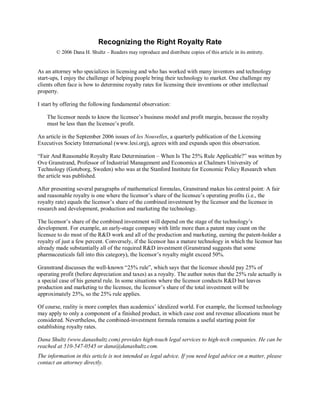More Related Content
More from David Libby (9)
Recognizing The Right Royalty Rate
- 1. Recognizing the Right Royalty Rate
© 2006 Dana H. Shultz – Readers may reproduce and distribute copies of this article in its entirety.
As an attorney who specializes in licensing and who has worked with many inventors and technology
startups, I enjoy the challenge of helping people bring their technology to market. One challenge my
clients often face is how to determine royalty rates for licensing their inventions or other intellectual
property.
I start by offering the following fundamental observation:
The licensor needs to know the licensee’s business model and profit margin, because the royalty
must be less than the licensee’s profit.
An article in the September 2006 issues of les Nouvelles, a quarterly publication of the Licensing
Executives Society International (www.lesi.org), agrees with and expands upon this observation.
“Fair And Reasonable Royalty Rate Determination – When Is The 25% Rule Applicable?” was written by
Ove Granstrand, Professor of Industrial Management and Economics at Chalmers University of
Technology (Goteborg, Sweden) who was at the Stanford Institute for Economic Policy Research when
the article was published.
After presenting several paragraphs of mathematical formulas, Granstrand makes his central point: A fair
and reasonable royalty is one where the licensor’s share of the licensee’s operating profits (i.e., the
royalty rate) equals the licensor’s share of the combined investment by the licensor and the licensee in
research and development, production and marketing the technology.
The licensor’s share of the combined investment will depend on the stage of the technology’s
development. For example, an earlystage company with little more than a patent may count on the
licensee to do most of the R&D work and all of the production and marketing, earning the patentholder a
royalty of just a few percent. Conversely, if the licensor has a mature technology in which the licensor has
already made substantially all of the required R&D investment (Granstrand suggests that some
pharmaceuticals fall into this category), the licensor’s royalty might exceed 50%.
Granstrand discusses the wellknown “25% rule”, which says that the licensee should pay 25% of
operating profit (before depreciation and taxes) as a royalty. The author notes that the 25% rule actually is
a special case of his general rule. In some situations where the licensor conducts R&D but leaves
production and marketing to the licensee, the licensor’s share of the total investment will be
approximately 25%, so the 25% rule applies.
Of course, reality is more complex than academics’ idealized world. For example, the licensed technology
may apply to only a component of a finished product, in which case cost and revenue allocations must be
considered. Nevertheless, the combinedinvestment formula remains a useful starting point for
establishing royalty rates.
Dana Shultz (www.danashultz.com) provides hightouch legal services to hightech companies. He can be
reached at 5105470545 or dana@danashultz.com.
The information in this article is not intended as legal advice. If you need legal advice on a matter, please
contact an attorney directly.

